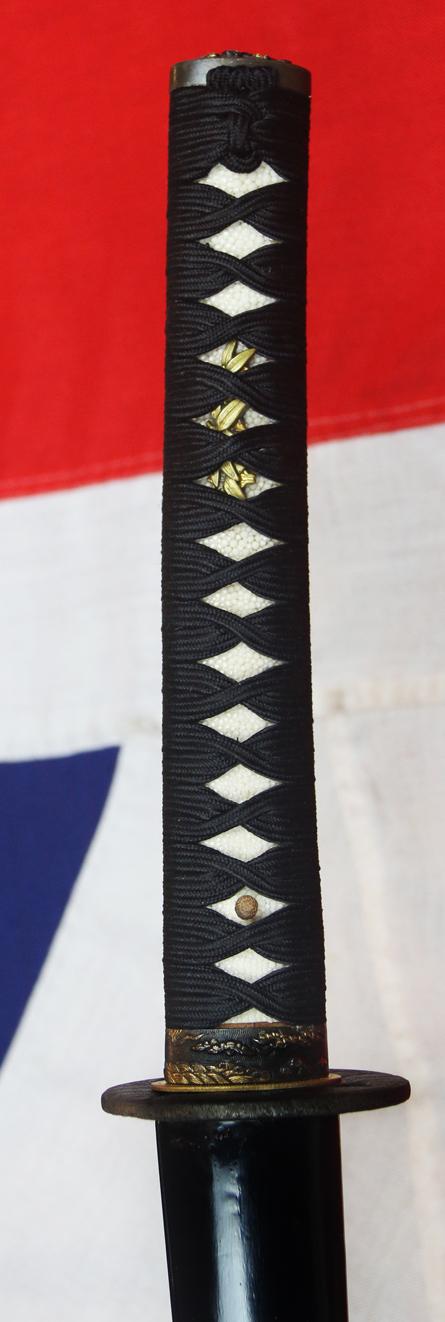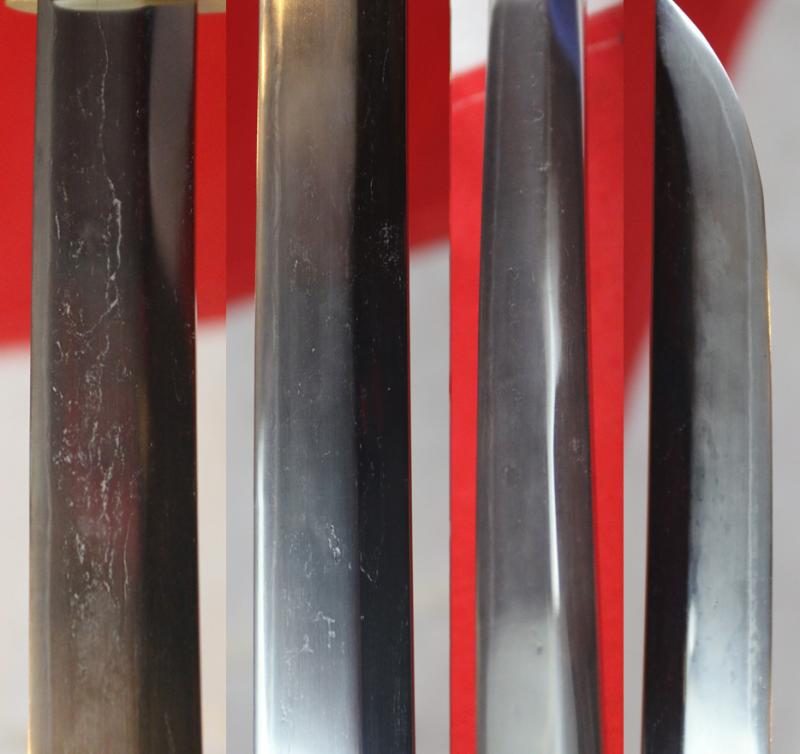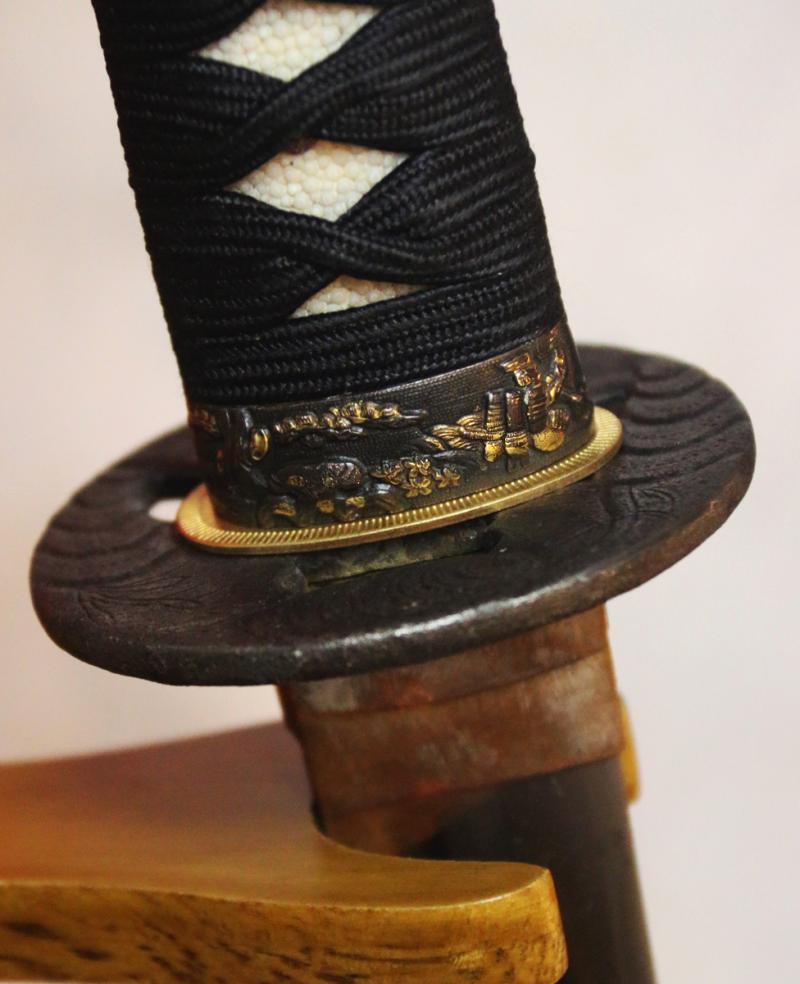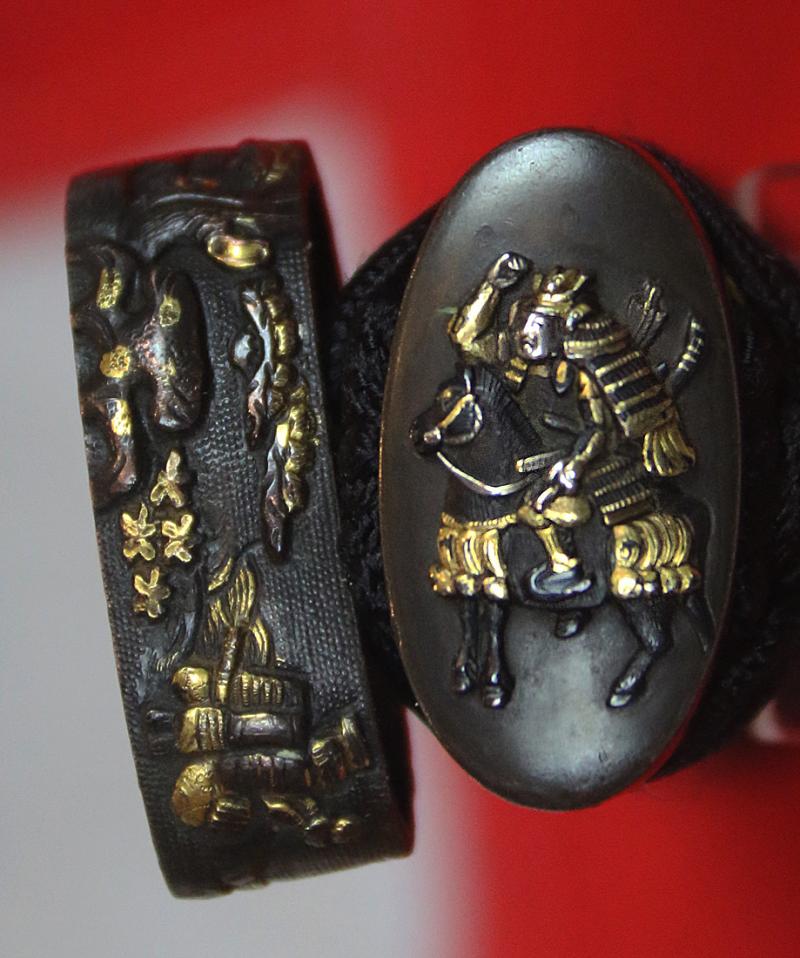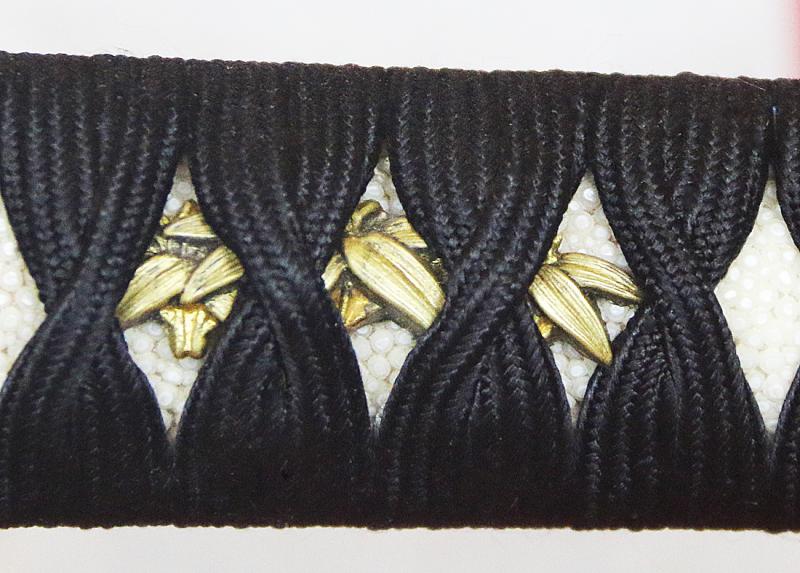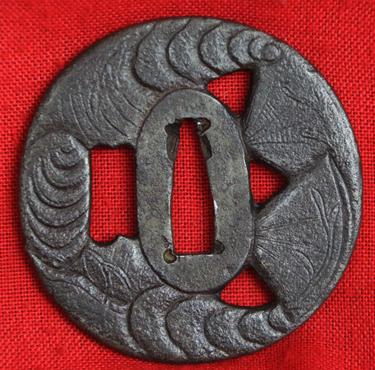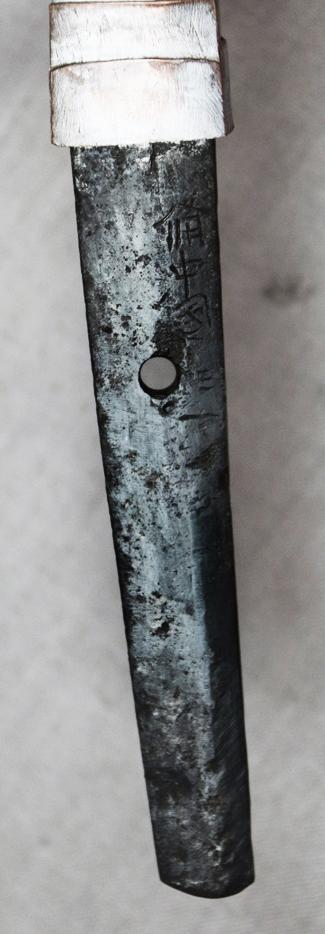A Most Beautiful Signed Koto Katana, Circa1500's. All Original Edo Mounts of Onlaid Pure Gold, Silver & Shakudo Fuchi-Kashira of A Samurai Warrior In Armour On Horseback
A circa 500 year old Koto period samurai katana blade, with a signed nakago, Bitchu ju Kuni... {the last part of the name can't be clearly read}.
It has a very good suguha hamon, and a traditional silk bound over samegawa gint rayskin tsuka, with stunning shakudo fuchi-kashira with gold and silver decoration of a takebori samurai on horseback on the kashira, and a samurai by a shoreline with overhanging trees and wave,s on the fuchi, beautiful gold bamboo leaves menuki, circular iron tsuba chiselled with leaves, in its black urushi lacquered saya. Black tsuka-ito over gold bamboo leaves, on samegawa giant rayskin.
The motif of this iron tsuba’s takebori design seems to be numerous conch shells, known as “Horagai” (法螺貝). The conch shell originates from Hinduism and is closely linked to the teachings of Buddha. Historically, Yamabushi (mountain ascetics) used it to convey sermons. The conch was brought to Japan around 806 AD by monks like Kukai (空海) and Saicho (最澄), who returned from Tang China, with five of the eight bringing conch shells. Its sound represents the teachings of Buddha, making it a sacred instrument in Japanese esoteric Buddhism. The conch is one of the Eight Auspicious Symbols in Tibetan Buddhism, symbolizing purity and the dissemination of Buddhist teachings.
Shellfish have been eaten all over the world since ancient times. At the same time, they have been used in a wide variety of applications, such as coins, ornaments, daily necessities, and toys, due to the beauty and preservability of their shells. In Japan, there is also a folk belief that seashells with prominent projections are hung from the eaves to ward off evil spirits, and their names are said to ward off fire, such as the Suijigai (水字貝, 水 means water in Japanese). In addition, ascetic monks who trained in the mountains blew trumpet shells to exorcise evil spirits. During the Warring States period (戦国時代, 1467-1615), trumpet shells were used to signal the formation of battle lines and to boost the fighting spirit. It is only natural that this shell, which was used as a cue in battle and to raise the fighting spirit of soldiers, was incorporated into the decoration of armour, which is the uniform of fighting.
The samurai were roughly the equivalent of feudal knights. Employed by the shogun or daimyo, they were members of hereditary warrior class that followed a strict "code" that defined their clothes, armour and behaviour on the battlefield. But unlike most medieval knights, samurai warriors could read and they were well versed in Japanese art, literature and poetry.
Samurai endured for almost 700 years, from 1185 to 1867. Samurai families were considered the elite. They made up only about six percent of the population and included daimyo and the loyal soldiers who fought under them. Samurai means "one who serves."
Samurai were expected to be both fierce warriors and lovers of art, a dichotomy summed up by the Japanese concepts of to stop the spear expanding into bushido (the way of life of the warrior) and bun (the artistic, intellectual and spiritual side of the samurai). Originally conceived as away of dignifying raw military power, the two concepts were synthesised in feudal Japan and later became a key feature of Japanese culture and morality.The quintessential samurai was Miyamoto Musashi, a legendary early Edo-period swordsman who reportedly killed 60 men before his 30th birthday and was also a painting master. Members of a hierarchal class or caste, samurai were the sons of samurai and they were taught from an early age to unquestionably obey their mother, father and daimyo. When they grew older they were trained by Zen Buddhist masters in meditation and the Zen concepts of impermanence and harmony with nature. The were also taught about painting, calligraphy, nature poetry, mythological literature, flower arranging, and the tea ceremony.
As part of their military training, samurai were taught to sleep with their right arm underneath them so if they were attacked in the middle of the night and their the left arm was cut off the could still fight with their right arm. Samurai that tossed and turned at night were cured of the habit by having two knives placed on either side of their pillow.
Samurai have been describes as "the most strictly trained human instruments of war to have existed." They were expected to be proficient in the martial arts of aikido and kendo as well as swordsmanship and archery---the traditional methods of samurai warfare---which were viewed not so much as skills but as art forms that flowed from natural forces that harmonized with nature.
Some, it is said, warriors, didn't become a full-fledged samurai until he wandered around the countryside as begging pilgrim for a couple of years to learn humility. When this was completed they achieved samurai status and receives a salary from his daimyo paid from taxes (usually rice) raised from the local populace. Swords in Japan have long been symbols of power and honour and seen as works of art.
Shakudo {that can be used to make samurai sword mounts and fittings} is a billon of gold and copper (typically 4-10% gold, 96-90% copper) which can be treated to form an indigo/black patina resembling lacquer. Unpatinated shakudo Visually resembles bronze; the dark colour is induced by applying and heating rokusho, a special patination formula.
Shakudo was historically used in Japan to construct or decorate the finest katana fittings such as fuchi-kashira, tsuba, menuki, and kozuka; as well as other small ornaments. When it was introduced to the West in the mid-19th century, it was thought to be previously unknown outside Asia, but recent studies have suggested close similarities to certain decorative alloys used in ancient Egypt, Greece, and Rome.
Blade surface has areas of the usual age surface micro thinning seen in Koto blades
Blade 27.25 inches long tsuba to tip, overall sword length in saya 38 inches long
Code: 24182
7250.00 GBP




